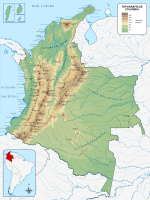Portal:Colombia
Colombia articles: History | Politics | Geography | Provinces | Economy | People | Culture | Café de Colombia | and much more...
The Colombia Portal
Colombia, officially the Republic of Colombia, is a country primarily located in South America with insular regions in North America. The Colombian mainland is bordered by the Caribbean Sea to the north, Venezuela to the east and northeast, Brazil to the southeast, Ecuador and Peru to the south and southwest, the Pacific Ocean to the west, and Panama to the northwest. Colombia is divided into 32 departments. The Capital District of Bogotá is also the country's largest city hosting the main financial and cultural hub. Other major urbes include Medellín, Cali, Barranquilla, Cartagena, Santa Marta, Cúcuta, Ibagué, Villavicencio and Bucaramanga. It covers an area of 1,141,748 square kilometers (440,831 sq mi) and has a population of around 52 million. Its rich cultural heritage—including language, religion, cuisine, and art—reflects its history as a colony, fusing cultural elements brought by immigration from Europe and the Middle East, with those brought by the African diaspora, as well as with those of the various Indigenous civilizations that predate colonization. Spanish is the official language, although Creole, English and 64 other languages are recognized regionally. Colombia has been home to many indigenous peoples and cultures since at least 12,000 BCE. The Spanish first landed in La Guajira in 1499, and by the mid-16th century, they had colonized much of present-day Colombia, and established the New Kingdom of Granada, with Santa Fé de Bogotá as its capital. Independence from the Spanish Empire was achieved in 1819, with what is now Colombia emerging as the United Provinces of New Granada. The new polity experimented with federalism as the Granadine Confederation (1858) and then the United States of Colombia (1863), before becoming a republic—the current Republic of Colombia—in 1886. With the backing of the United States and France, Panama seceded from Colombia in 1903, resulting in Colombia's present borders. Beginning in the 1960s, the country has suffered from an asymmetric low-intensity armed conflict and political violence, both of which escalated in the 1990s. Since 2005, there has been significant improvement in security, stability, and rule of law, as well as unprecedented economic growth and development. Colombia is recognized for its healthcare system, being the best healthcare in Latin America according to the World Health Organization and 22nd in the world. Its diversified economy is the third-largest in South America, with macroeconomic stability and favorable long-term growth prospects. Colombia is one of the world's seventeen megadiverse countries; it has the highest level of biodiversity per square mile in the world and the second-highest level overall. Its territory encompasses Amazon rainforest, highlands, grasslands and deserts. It is the only country in South America with coastlines (and islands) along both the Atlantic and Pacific oceans. Colombia is a key member of major global and regional organizations including the UN, the WTO, the OECD, the OAS, the Pacific Alliance and the Andean Community; it is also a NATO Global Partner and a major non-NATO ally of the United States. (Full article...) Selected article -"Te Lo Agradezco, Pero No" (English: "Thank you, but no") is a song recorded by Spanish singer Alejandro Sanz and Colombian singer Shakira, for Sanz's eighth studio album El Tren de los Momentos (2006). It was released as the second single from the record in December 2006 by Warner Music Latina. The track was written by Sanz, while production was handled by him along with Lulo Pérez. "Te Lo Agradezco, Pero No" is the second duet recorded by the two singers, following "La Tortura" for Shakira's album Fijación Oral Vol. 1 (2005). The song came about after she approached Sanz, telling him that she wanted to collaborate on something different from her own material. Upon its release, "Te Lo Agradezco, Pero No" was perceived as an album highlight by several music critics. It earned the duo multiple awards and nominations, including Song of the Year at the 2007 Premios Oye!. Commercially, the single was successful in Venezuela and on the American Latin music charts, where it topped the Billboard Hot Latin Songs and Latin Pop Airplay charts. A music video for the song, directed by Jaume de Laiguana, was filmed in Brooklyn and released on 11 January 2007. It is a continuation of the clip for Sanz's "A la Primera Persona" and it features the duo dancing together towards the end. Sanz performed the song live during his El Tren De Los Momentos Tour (2007–08). (Full article...)Related portalsCategoriesSelected biography -Manuel de Trujillo y Torres (November 1762 – July 15, 1822) was a Colombian publicist and diplomat. He is best known for being received as the first ambassador of Colombia by U.S. President James Monroe on June 19, 1822. This act represented the first U.S. recognition of a former Spanish colony's independence. Born in Spain, he lived as a young adult in the colony of New Granada (present-day Colombia). After being implicated in a conspiracy against the monarchy he fled in 1794, arriving in the United States in 1796. From Philadelphia he spent the rest of his life advocating for independence of the Spanish colonies in the Americas. Working closely with newspaper editor William Duane he produced English- and Spanish-language articles, pamphlets and books. (Full article...)Did you know (auto-generated)
General imagesThe following are images from various Colombia-related articles on Wikipedia.
Selected pictureLargest cities
TopicsNew articlesThis list was generated from these rules. Questions and feedback are always welcome! The search is being run daily with the most recent ~14 days of results. Note: Some articles may not be relevant to this project.
Rules | Match log | Results page (for watching) | Last updated: 2024-04-17 20:49 (UTC) Note: The list display can now be customized by each user. See List display personalization for details.
WikiprojectsThings you can doIf you are interested in helping with this portal, please join WikiProject Colombia or one of its child projects: Article requests
History (High priority)
Society
Scouting
People (Medium priority)Physical geography
Media (Medium Priority)Government and political affairs (High priority)
Wikipedia's portalsDiscover Wikipedia using portals Sources | |||||||||||||||||||||||||||||||||||||||||||||||||||||||||||||||||||||||||||||||||||||||||||||||||||||||||||||||



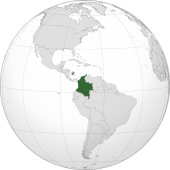







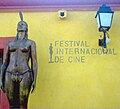



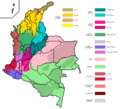











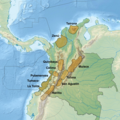









![Image 2Tall ship ARC Gloria, insignia of Colombia. She is a training ship and official flagship of the Colombian Navy.[1]](http://upload.wikimedia.org/wikipedia/commons/thumb/e/eb/ARC_Gloria_by_Will_White.png/120px-ARC_Gloria_by_Will_White.png)









